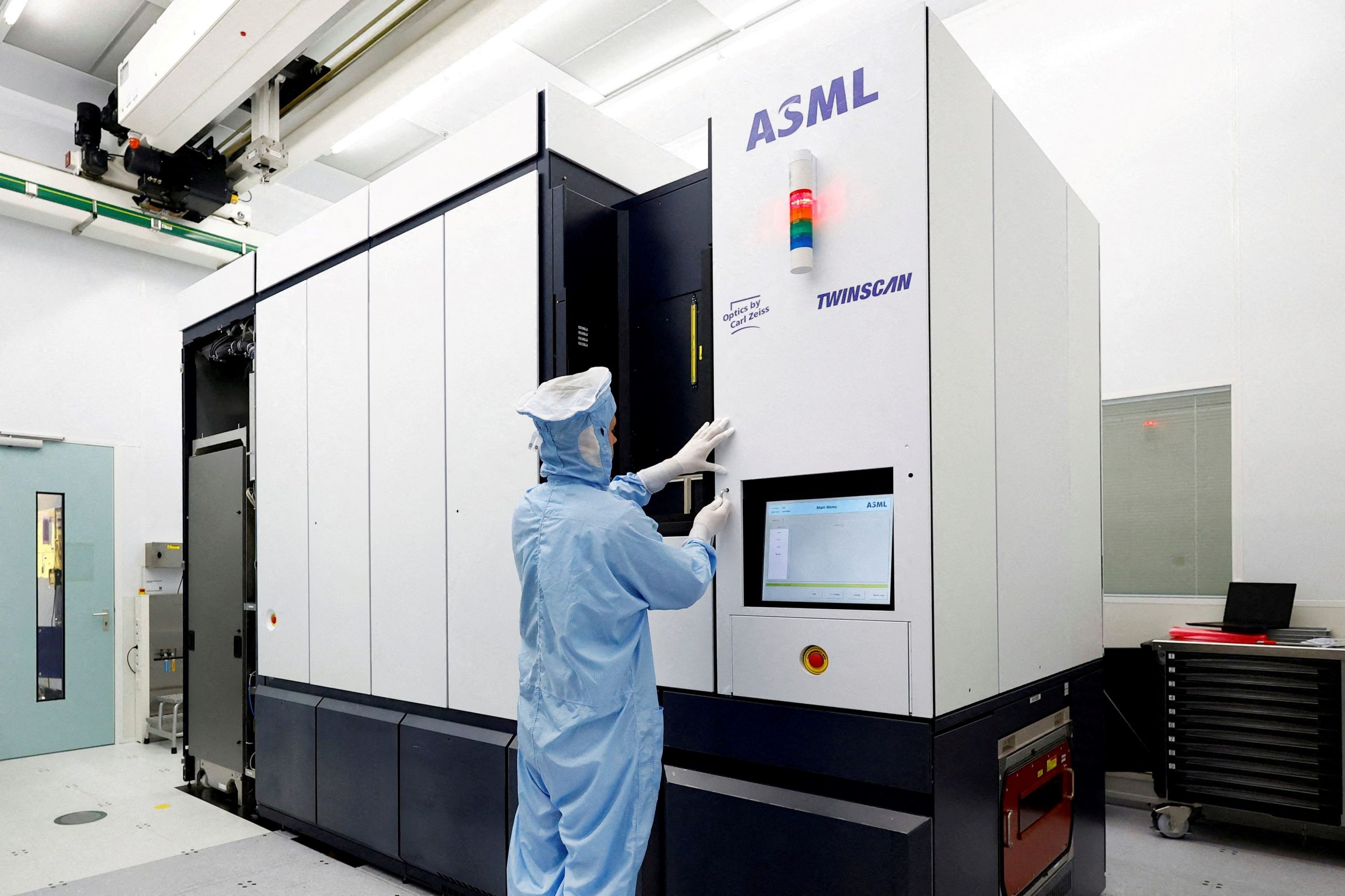BOISE, Idaho—Brienna Hall has the most valuable role that you’ll never see at the most vital company that you’ve never heard of.
Until she began working at ASML last year, she didn’t know the first thing about the company. She also didn’t know what she would be doing as a customer-support engineer—a “fancy mechanic,” as she calls herself.
And she had absolutely no idea that it would be essential to the global economy.
When she reports for her shift at a chip plant, Hall slips into a bunny suit. She enters a room where the pristine air is 100 times cleaner than a hospital operating room’s. Then she makes her way over to an unfathomably complex machine.
Her job is to know everything about it—so that she can fix it.
“I thought I had the coolest job ever,” Hall says. “I didn’t process the fact that this job is necessary for our entire world to exist as it does.”
The piece of equipment that the entire world has come to rely on—and she is specially trained to handle—is called an extreme ultraviolet lithography machine.
It’s the machine that produces the most advanced microchips on the planet. It was built with scientific technologies that sound more like science fiction—breakthroughs so improbable that they were once dismissed as impossible. And it has transformed wafers of silicon into the engines of modern life.
Even today, there are only a few hundred of these EUV machines in existence—and they are ludicrously expensive. The one that Hall maintains cost $170 million, while the latest models sell for roughly $370 million.
But maybe the most remarkable thing about these invaluable machines is that they’re all made by the same company: ASML.
ASML is the glue holding the chip business together. That’s because this one Dutch company is responsible for all of the EUV lithography systems that help make the chips in so many of your devices. Like your phone. And your computer. And your tablet. And your TV. Maybe even your car, too.
These machines have become indispensable. And they depend on the invisible work of Brienna Hall.
She’s one of the engineers assigned to the fabrication plants—or fabs—where ASML customers manufacture their semiconductors. Hall is based here in Boise, the headquarters of Micron Technology , where I hopped into a bunny suit of my own and followed her inside the chip fab.
Then I got a rare, behind-the-scenes peek at what might just be the most important machine ever made.
Going to extremes
EUV machines aren’t so much a marvel as they are a miracle.
Their origin story begins 40 years ago in a leaky shed in the Netherlands with the birth of Advanced Semiconductor Materials Lithography—now simply ASML . Back then, printing chips with extreme ultraviolet light was a fantastical idea. Making it a reality would require more time and money than the visionaries who dreamed up this magical technology could have possibly foreseen.
It’s a process that involves vaporizing droplets of molten tin and producing light that doesn’t occur naturally on Earth.
Or at least that’s the simplest way to understand the the extremely intricate science of extreme ultraviolet lithography.
The droplets get zapped by twin laser pulses—explosions that happen 50,000 times a second. The first pulse flattens them. The second one obliterates them into a plasma that emits the EUV light. That light is then collected using the smoothest mirrors ever invented and directed toward the silicon wafer to etch billions of microscopic transistor patterns.
The existential question of the semiconductor industry is how to pack more and more of those transistors on chips to make them faster and faster. The answer: shorter and shorter wavelengths of light. ASML’s first lithography tools created light at wavelengths of 436 nanometers. The current machines have shrunk that number to 13.5 nanometers. That allows them to fabricate chips at resolutions 10,000 times finer than human hair.
The more I heard about extreme ultraviolet lithography, the more extraordinary it sounded that anyone ever figured it out.
And there are two things I learned about the EUV tool I saw that I can’t get out of my head:
It took decades for these absurdly sophisticated machines to make their way from labs to fabs. And until recently, it wasn’t clear if the company’s audacious bet on EUV lithography would ever pay off. In 2012, ASML was strapped for cash and sold a 23% equity stake to Intel, Samsung Electronics and Taiwan Semiconductor Manufacturing , which meant its biggest customers were literally invested in the company’s success.
ASML soon ramped up production—very, very slowly. The company delivered the first EUV system in 2010. Not until 2020 did it deliver the 100th. And last year was a busy one: ASML shipped a total of 42 EUV machines.
There are still only six companies that own these machines for chip manufacturing. But many others indirectly depend on ASML—including the most valuable companies in history.
Apple and Nvidia both design their own chips and outsource production to the fabs of TSMC , which means ASML’s tech is pivotal for making everything from AI data centers to iPhones.
EUV machines have become so crucial that the company now employs an army of 10,000 customer-support employees to keep them humming.
“They are the front-line troops of ASML,” said Jim Koonmen, the company’s chief customer officer.
ASML’s clients expect their lithography tools to be operating day and night, but disruptions are inevitable and unpredictable, as Dutch journalist Marc Hijink writes in “Focus,” his book about the company.
TSMC worries about earthquakes. Intel once traced a lithography issue back to another kind of rumble—a shift in wind patterns that was carrying over methane gas from nearby dairy farms.
“Cow farts,” Hijink wrote.
Bovine flatulence aside, malfunctions are rare. But the EUV machine is the bottleneck of every fab. The entire factory gets backed up if it goes down—which is why ASML employs people around the clock all over the world.
People like Brienna Hall.
The education of a fancy mechanic
Long before she ever heard of ASML, there were signs that she would fit right in.
Hall, 29, grew up in Seattle as a Girl Scout obsessed with tying the perfect knot. She was president of the Edmonds College rocketry club when she got her associate degree. At Washington State University, she majored in materials science and engineering—and transcribed notes for a professor writing a textbook on quantum mechanics. She loves planning camping trips even though she doesn’t actually like camping. In her spare time, she works with her hands, quilting and piecing together elaborate Ravensburger jigsaw puzzles.
All of which turned out to be excellent preparation for navigating a machine with more than 100,000 parts.
“You’re always problem-solving,” said Alex Jordan, another ASML engineer. “How can I be more efficient? Where can I optimize this ? And what if we tried that ?”
When the company recruits for customer-support positions, ASML looks for diligent, disciplined and detail-oriented engineers. Hall had the right kind of technical mind and temperament for the job. When one of her professors heard that a semiconductor company was hiring, Hall passed along her résumé and soon received emails from ASML asking her to apply.
Most college students know nothing about ASML. In fact, they probably know more about ASMR .
Hall was intrigued when her interviewer asked how she felt working in tight spaces and bunny suits. Then she found out the entry-level job included extensive travel. That was all she needed to hear to accept the offer from ASML. “I always wanted to travel,” she said, “and I’d barely been down the West Coast.”
Her first long trip was a month in Taiwan for her Fab Ready 1 course at ASML’s training center, where she familiarized herself with the EUV machine’s parts: the scanner (the part with the mirrors that focus the light onto the wafer), the source (the part that generates the light) and the drive laser (the part with the lasers).
She also learned that each part has its own personality. At the Micron fab, the scanner is called Monica—as in the “Friends” character.
“Because everything must be perfect,” Hall says. “The conditions must be just so for her to function.”
She came to know Monica when she returned to Boise for on-the-job training. Meanwhile, she developed her expertise through months of Fab Ready 2 classes in Taiwan, San Diego and Germany, where she made a pilgrimage to the puzzle mecca of Ravensburg.
She apprenticed for nearly a full year before she was cleared to work on the EUV machine by herself. When she’s not on different continents, Hall is stationed in the ASML office a short drive from Micron’s campus. She works in 12-hour shifts, from 6 a.m. till 6 p.m. In the winter, she comes to work long before sunrise and leaves well after sunset.
Some days, she goes straight to the fab. Other days, she’s at her desk, looking at numbers on her multiple screens until “I’m sure the machine isn’t going to self-combust,” she says. At that point, Hall shifts her attention to planning the series of actions she will perform during the “scheduled down,” a routine outage for preventive maintenance to minimize the risk of an “unscheduled down.”
After all, the only thing more satisfying than fixing a machine is having a machine that doesn’t need to be fixed.
But any kind of work on the machine is what she considers fun. It’s dealing with other people that she finds stressful.
“Our machine is complex enough that it has a personality, but it’s still a machine. If you hit the right buttons, she will come up. You just have to figure out what buttons to press. I can solve that. We can solve that,” Hall said. “Humans are vastly more complex than any machine that I know of.”
Fab life
Nearly a half-century ago, when four entrepreneurs in Boise founded Micron in the basement of a dentist’s office, one of their investors was a local potato baron. In Idaho, it turns out even the microchips come from potatoes.
These days, Micron is building a $15 billion fab here to bring leading-edge memory manufacturing back to U.S. soil. The factory under construction will be the size of 10 football fields. Its foundation required four times the amount of concrete as the Empire State Building .
And next to the dozens of massive cranes on Micron’s campus is the company’s existing research fab.
Inside is a machine that weighs more than 300,000 pounds and was chauffeured from the Netherlands on three 747 cargo planes.
Brienna Hall never goes more than a few days of work without going into the fab to see that EUV machine.
“By then I get itchy,” she said, “and I make a reason to go in.”
So we did.
Whenever she goes into the cleanroom, she covers herself from head to toe, since even a speck of dust can have disastrous consequences. She also makes sure she won’t have to go to the bathroom. “I’ll space out and limit my sips of water—and I won’t drink coffee,” she says.
Under the dim yellow lights, it’s hot and loud and disorienting. But not to her. When she’s in the fab, she’s often in a flow state.
Hall talks about troubleshooting an EUV machine the way Stephen Curry talks about shooting a basketball.
“When I’m on the tool and fixing a problem, it’s like everything else goes quiet—and I’m just focused on getting that one thing done,” she says. “And there’s nothing better than just zeroing in on that problem until it’s solved.”
The machine had been taken out of production mode by the time we entered the bottom level of the fab.
We had two hours—and the clock was ticking.
She glanced at her laptop to review the details of this service plan. Then we proceeded through a maze until Hall stopped, removed the door of a cabinet and squeezed inside the machine. While she was fiddling with a tangle of cables in tight quarters, I looked around and noticed the red emergency buttons everywhere. Before I could worry about bumping into one, Hall popped out.
“There’s a hose that isn’t doing what it’s supposed to,” she declared.
A blockage in the water line meant the hose wasn’t cooling properly—and now it was having some heat issues. When she touched the hose, Hall could feel a minor distortion. Which had the potential to be a major problem. Even this barely perceptible warpage could bring the whole machine down if the hose burst. That rupture would activate the leak sensor and trigger an immediate stop—the equivalent of smashing one of those red emergency buttons.
ASML’s engineers knew this circuit was under strain and had a plan to address it during the next scheduled down. But that was still three weeks away.
They could wait until then. Or she could just solve the problem now.
Hall laid out the situation to a Micron official and he authorized her to proceed with the repair on the spot.
And that’s when she reached for two Home Depot buckets.
She needed the orange pails that cost $3.98 at the hardware store before she could fix a machine that sells for a few hundred million dollars. To swap out the hose without spraying water everywhere, Hall drained the water line until both tubs were almost full. She carefully replaced the Teflon hose, attached thermal sensors for monitoring and shut the door behind her.
It was time for the machines to get back to work.
“From an engineering perspective, it’s a little dull,” Hall said. “But I’ve learned to take pride in the fact that my machines are staying up and producing for our customers.”
She had done exactly what she was supposed to do in exactly the way she was supposed to do it.
And nobody in the world outside would ever know.



